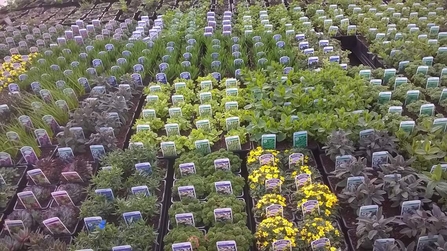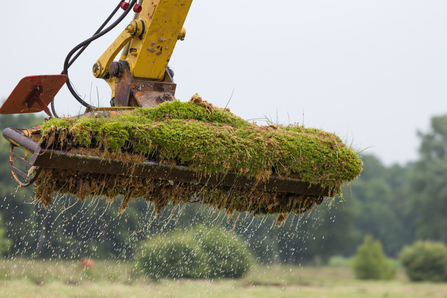Commercial peat extraction to generate peat as a product occurs mainly on raised bogs (but occasionally on blanket and fen peat) to provide peat for gardening, horticulture, whisky production, animal bedding and other uses. Mechanised peat removal has a major ecological impact, stripping away the living layer and, subsequently, exposing large quantities of peat to oxidation and loss of carbon. Neighbouring areas of peatland within the same hydrological unit can become degraded because of the drastically lowered water table. This means that the carbon, biodiversity and water quality impacts of peat extraction can reach far beyond the footprint of the extraction site itself. The threat to rare lowland peatland habitats and species, as well as the costs to society from the loss of peatland services such as carbon storage, water filtration and flood management, makes a strong case for ending the use of peat.
Peat removal has a major impact on peatlands. Credit Clifton Bain
Peat use in the UK
Currently, nearly three million cubic metres of peat are sold for horticultural use every year in the UK, one third of which comes from UK peatlands. The latest monitoring data from the Horticultural Trades Association (HTA) Growing Media Monitor Report (2022) shows that the overall proportion of peat in horticultural growing media fell from 41% in 2020 to 36% in 2021. The total quantity of peat used - 1,690,000 cubic metres - also decreased for the first time in eight years, with 600,000 cubic metres less peat being used in the sector in 2021 compared to 2020.
The retail market still accounts for most of the total volume of growing media used, making up 72% of the total market. The reduction in peat use has been greatest in this sector, with more immediate options for substituting peat than in the professional grower market. Some large retailers have voluntarily stopped selling bagged peat-based compost, although the sale of plug plants and bedding plants grown in peat is still widespread. Within the retail sector, peat now makes up about 30% of the materials used and this is set to fall further with retailer commitments to reduce peat use. Around 1 million cubic metres of peat is currently still being used for amateur gardening products.

Bedding plants at Quinky peat-free wholesale nursery in Cardigan, Wales. Credit Charles Warner
We are now moving away from the polarised debates between defenders of peat use and those against. There are common goals across the horticulture industry, with some nurseries now voluntarily peat-free, and many in the process of transition. However, complex supply chains and a lack of legislation to drive this forward mean that progress is slow. Important crops like mushrooms are largely grown in extracted peat, and although peat-free alternatives are increasingly available, mushroom growing accounts for around a ninth of the peat extracted in the UK.
As peat use by the horticulture sector reduces, other end users of extracted peat become more prominent. Small volumes of peat extracted from commercial extraction sites and more local hand-cutting sites are used in the food and drink industries, for example in whisky production. The industry recognises the need to ensure peat use is minimised and that the industry itself will need to play an increasing role in protecting and restoring peatland habitats.
Peat is still cut by hand for smaller industries such as whisky. Credit Emma Hinchliffe
Some localised extraction for domestic fuel continues, particularly in the Scottish Isles and in Northern Ireland, where it is an important part of cultural heritage.
Moving beyond peat in horticulture
Some permissions for peat extraction on existing sites extend up until 2042. The English government committed to ending the sale of horticultural peat for amateur gardening by 2024 with later bans planned for professional use, but this deadline was missed, and at the time of writing, legislation is still not forthcoming. In Scotland there have been calls to extend use beyond England’s proposed deadline for industry of 2030, and there has not been noteworthy progress towards ending retail sales of bagged peat compost. The Welsh government also said that peat compost sales would be phased out by the end of 2024, but failed to deliver on this promise. In Northern Ireland, references to the proposed 2025 ban on horticultural peat were removed from the 2022 update to the Peatland Strategy.
Existing peat extraction sites represent opportunities for restoration back to peatland habitat or intermediate land uses, such as paludiculture, which protect remaining peat extent but also offer the option to produce peat-free growing media. Large scale trials of growing Sphagnum as a ‘white peat’ replacement have shown promise in minimising greenhouse gas emissions from extraction sites whilst also delivering an economically viable product and wider benefits.

First mechanical harvest of cultivated peatmoss at a pilot Sphagnum farming site. Credit Tobias Dahms
Society demands urgent action by all sectors on the intimately linked crises of climate change and biodiversity loss. All businesses must respond to our global commitments to demonstrate sustainable practices and deliver net zero emissions.
Our work
The IUCN UK Peatland Programme has worked with several partners, including UK and devolved governments, to investigate the restrictions around peat extraction and site restoration. We have also supported research and policy to enable the development of sustainable, peat-free alternatives. We will continue to work with all partners, including those in the Peat-free Partnership, to support the introduction of a ban and any supporting guidance that may be needed post legislation being introduced.
Downloads
Demonstrating Success - Peat-free Horticulture Addendum 2023
Demonstrating Success - Peat-free horticulture 2021
Briefing: Commercial Peat Extraction (2014)
A discussion briefing for Scotland’s National Peatland Plan Steering Group (2016)
Review of extant planning permissions for commercial peat extraction in Scotland (2017)
Horticulture and Peat in Scotland - Roundtable Notes (April 2017)
